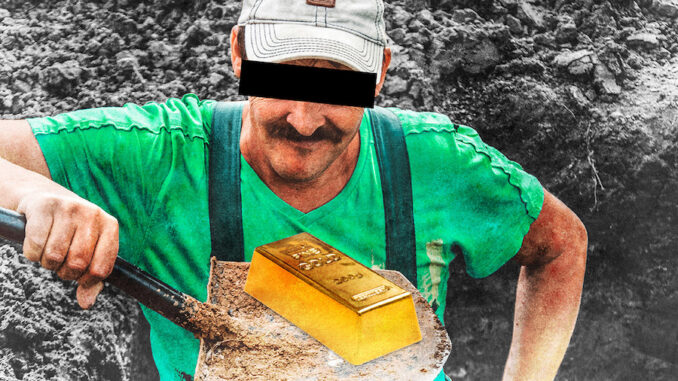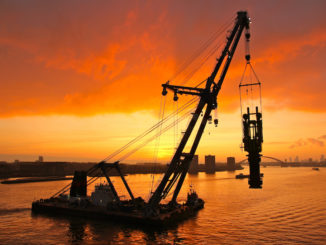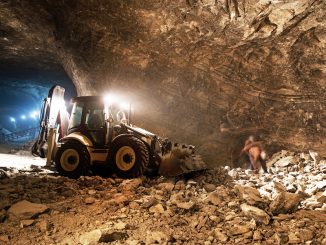
To all you contractors out there… you are in an ideal situation to find treasure… and you don’t even realize it.
In fact—in this article—we’re going to prove to you why contractors and heavy equipment owners have a better chance of finding and securing treasure more than the average person.
Did you know that a lot of the treasure found wasn’t even found by professional treasure hunters? There are plenty of stories where priceless treasures have been found by regular people.
Consider how—in April, 2014—a California couple was on a walk with their dog when they found a metal can sticking out of the ground. A basic dig would reveal a large cache of gold coins inside.
Or—in 2010—a man named David Crisp used a metal detector to uncover a large collection of Roman coins in a small town in England. His total find would be estimated over $400,000 dollars.
An 18th-century ship was even found by accident during the excavation of the World Trade Center site after the 9/11 attacks.
Like this example, there are many other stories where construction workers found treasure by accident. Imagine what you and your crew can accomplish with your equipment and knowledge of the land.
The fact is there is still a lot of treasure that hasn’t been found. And—in some of these cases—some of these finds will be worth billions, alone.
This article is going to cover the types of equipment used to find treasure, locations where treasure can potentially be found, how to utilize your contracting skills to find treasure, and everything else you need to know to help you utilize your resources at-hand… to find the motherload.
Why Contractors Make Excellent Treasure Hunters
The right attitude. Treasure hunting takes patience, hard work, thick skin, and time. It can actually be brutal and has pushed treasure hunters over the edge—some have lost all of their money, their minds, and even their lives. That being said—as most of us reading this article already know—contractors are some of the toughest SOBs on the planet. Contractors have the experience and mindset necessary to do whatever it takes in the pursuit of treasure.
Experienced equipment owners and operators. This is a big one. How many non-contractors do you know who can operate an excavator or crane? Not many at all, right? Having experience operating heavy equipment, and—even better—owning the equipment—immediately puts you ahead of the competition. The average treasure hunter spends much of their budget—which is limited to begin with—on heavy equipment rentals and operators day… after day… after day.
Knowledge of the land. Contractors have extensive experience with the land—including reading maps, understanding soil composition, and excavating different types of terrain. Considering that most treasure is found underground, this knowledge is essential for the pursuit of treasure.
Surveying tools. Many contractors are experienced with surveying tools such as ground-penetrating radar and metal detection. These types of tools are crucial for pinpointing exact treasure locations.
Access to land. Some contractors already have access to private land—or know someone who owns this land. Although it’s unlikely that this land contains the Holy Grail, you never know what is lurking beneath the surface. In fact, there are numerous examples of treasure that was found by chance in common areas.
For example—in 2012—while building residential homes—construction workers in Norway discovered an unusually well-preserved Viking sword over 1,000 years old—from a possible gravesite.
Collaboration with experts. Contractors are accustomed to collaborating with other contractors, engineers, divers, environmental consultants, inspectors, and—most of all—government agencies. This experience is invaluable when it comes to treasure hunting. Like most things in life… it’s all about relationships.
Experience with attorneys and contracts. There’s too many stories out there where naïve, inexperienced treasure hunters lost everything—because they didn’t cross the t’s and dot the i’s. If you’re planning on finding and securing treasure without the proper permits or permission from the government, then you’re wasting your time. But—as a contractor—you should have experience with working with attorneys and contractors so—once again—you are ahead of the competition.
Preservation. Obviously, preserving and properly excavating located treasure is crucial. But, this shouldn’t be a problem for contractors—since you are used to handling materials with care and working in sensitive areas like hazardous material sites, residential areas, military bases, and maybe even historic sites.
As far as reasons why contractors make ideal treasure hunters, we can go on-and-on. This is just a list of the reasons we feel are most important.

Essential Equipment for Treasure Hunting
In our opinion, owning the right equipment is half the battle when it comes to finding and securing treasure—and most of this equipment is already in the position of a lot of you contractors out there.
So what type of equipment is commonly used for treasure hunting? Let’s take a look…
Metal detectors. Metal detectors might be one of the smallest and cheapest type of equipment on this list, but they might be the most important. Even some of the biggest treasure hunts come down to a basic metal detector. Ever seen that show, the Curse of Oak Island? Well, consider how many times they’ve dumped a pile of soil on the ground and went through it with a metal detector. Also, there has been significant treasure found over the years with just a simple metal detector.
For example—in 2009—a metal detectorist discovered the Staffordshire Hoard—a collection of more than 3,500 Anglo-Saxon gold and silver artifacts in Staffordshire, England. The hoard is considered one of the largest and most valuable finds of Anglo-Saxon treasure ever discovered—with a value estimated to be in the millions.
Shovels and picks. While shovels are used to remove loose soil, gravel, and other debris from the ground—picks are used to break up compacted soil or rock. Both can be used before or after major excavation work. For example, shovels and picks may be used to clear away surface debris to create a clear, more-visible workspace before major excavation work begins. On the contrary, shovels and picks may be used after major excavation work takes place—like digging smaller-sized holes once you get closer to the anticipated treasure location, for example.
Sifting screens. Sifting screens are used to separate soil and debris from artifacts or other small, important objects. These screens typically consist of a metal frame and mesh screen, and they come in a variety of sizes and shapes.
Excavators. Needless to say, a robust excavator can handle most types of excavation work—especially when it comes to excavating potential treasure buried underneath the soil… but what if the treasure is beyond the excavator’s reach?
Drilling rigs. With the ability to reach far deeper than even the largest excavators, drilling rigs are designed to create boreholes for various purposes—including extracting soil and rock samples. Once the drill has reached the desired depth, the contractor (or treasure hunter) can use various tools to extract soil and rock samples from the borehole. These samples can then be analyzed to look for signs of treasure—or, in a perfect scenario—find the treasure itself.
Dredges. Considering that so many treasures have been found in oceans and rivers, a dredge is an instrumental piece of equipment for a treasure hunter. There are different types of dredges, but the general purpose of a dredge is to excavate underwater sediments and materials. For treasure hunting, the most ideal type of dredge would probably be the suction dredge—which can effectively collect small objects—like coins and jewelry—and is relatively easy to control the size of objects collected.
Ground-penetrating radar. Ground-penetrating radar—or “GPR”—is a geophysical imaging technique that uses radar pulses to image the subsurface of the ground. When it comes to treasure hunting, GPR can be used to identify potential underground structures or anomalies that may be associated with treasure. The cost of a GPR unit can vary depending on the type of unit and its capabilities—but an average, entry-level GPR unit can range from $3,000-$10,000—while a more advanced unit can cost $20,000 or more.
Geophysical sensors. Geophysical sensors are used to measure the physical properties of soil and rock—like density, for example. These sensors can be used to identify areas that may contain buried structures or artifacts. Entry-level sensors suitable for basic treasure hunting can cost a few thousand dollars—while more advanced sensors with higher resolution and greater accuracy can cost tens of thousands of dollars.
GPS devices. GPS devices can be used to map out the possible location of a treasure site—as well as tracking the ongoing excavation work. The cost of GPS devices can vary—depending on the type and features of the unit. Basic handheld GPS devices suitable for treasure hunting can cost anywhere from around $100 to $500. However, more advanced GPS units with features like high-resolution mapping, touchscreen displays, and built-in cameras can cost upwards of $1,000 or more.
Lighting equipment. For those contractors out there who work at night, you already know the importance of lighting when it comes to excavation work. Not only will you likely be doing some treasure hunting afterhours—but once that hole gets deeper and deeper, you’re going to need some sufficient lighting to see where you’re going. The key pieces of lighting equipment generally includes headlamps, flashlights, spotlights, tripod lights, and light sticks.
Safety equipment. And last—but, certainly not least—safety equipment is a must for your pursuit of treasure. Treasure hunting is a dangerous enterprise, and many have died over the years while doing so. We could do an entire article dedicated to safety, but—to keep it brief—here is a list of the basic safety items you may want to consider: hard hats, gloves, safety glasses, ear protection, respirators, first aid kits, and sun protection.
Well, there’s our list of—what we believe—are the most important pieces of equipment needed for treasure hunting. If you feel we left anything out, please comment below.
Now that we’ve covered equipment, let’s take a look at some possible locations where you can find treasure…
Where to Search for Treasure
Construction sites are potential locations to find treasure. In fact, we can list multiple instances where significant treasure was found by construction crews. In addition to the example mentioned earlier, another would be when—in 2016—construction workers in Spain who were laying pipe in a park unearthed a 1,300-pound trove of Roman coins.
Of course, shipwrecks are another ideal location for treasure hunting—especially for those of you—like us—who live on the coast. According to the Florida Division of Historical Resources, there are over 1,000 known shipwrecks in Florida waters, alone—and only a small handful of these shipwrecks have been discovered, let alone, excavated.
Ever heard of a guy named Mel Fisher? Well, In 1985, Fisher found a treasure trove of gold, silver, and other artifacts from the wreck of the Spanish galleon, Nuestra Señora de Atocha, off the coast of Florida—which was worth an estimated $400 million.
And you don’t need to be offshore to find treasure. Beaches turn up treasures of all kinds on a pretty regular basis—especially after large storms or heavy tides that reveal buried items. For example—in 2020—a pair of treasure hunters with a metal detector discovered a trove of Spanish coins from a 1715 shipwreck on a beach in Florida.
Abandoned buildings are another possible location for treasure. Abandoned buildings—particularly those with a rich history—may contain hidden treasures like antique furniture, artwork, or other valuable items. There are numerous examples of regular people finding treasure in abandoned buildings.
For example—in 2022—a while renovating their house, a couple found over $850,000 worth or rare coins underneath floorboards.
Natural landmarks like caves, mountains, and waterfalls have also been known to contain hidden treasures—such as minerals, gemstones, and precious metals. For example—in 2013—an amateur Australian prospector armed with a metal detector found a massive gold nugget worth more than $300,000 in an area known as the “Golden Triangle,” which was known for its rich veins.
Historical sites like battlefields and ancient ruins may also contain hidden treasures. For those of you living in states where Revolutionary War battles were once fought—like New York, New Jersey, Pennsylvania, the Carolinas, and other states that saw battle—countryside fields in these areas are excellent locations to look for valuable items like coins and weapons. There’s no telling what a simple metal detector can find at these historical sites.
This is just a list of common locations to find treasure. Can treasure be found elsewhere? Absolutely. You just need to know where to look. That’s why we’re going to talk about the importance of research and planning next…
Importance of Research and Planning
We know you want to break ground as soon as possible, but—without proper research and planning—it’s highly unlikely that you’re going to find treasure. Even if you’ve found the location of treasure, significant research and planning will likely still be required—that is, if you want to excavate the find properly without causing irreparable damage.
So what types of “research” and “planning” can you do exactly? Here are a couple suggestions to get you started…
Historical research. You can start by conducting historical research to identify potential treasure sites in a particular area. This research may involve researching local history, or even legends, to identify areas where valuable objects may have been deliberately hidden or lost over time.
For example—in 2021—a Dutch historian used his knowledge of history (and a metal detector, of course) to find a 1,000-year-old medieval golden treasure—consisting of four golden ear pendants, two stripes of gold leaf, and 39 silver coins.
Geographical research. In addition to historical research, there’s also geographical research—which may involve studying topographical maps, identifying areas with geological features that may be conducive to treasure burial, or using technology—like ground-penetrating radar—to identify potential treasure sites.
For example—approximately 10 years ago—a group of archaeologists in Mexico used LIDAR technology to map out the topography of the ancient city of Angamuco. They were able to identify over 26,000 structures—including pyramids, temples, and houses—which are home to all sorts of valuable artifacts.
So what if you have identified a potential treasure site? You’ll want to create an excavation plan in order to ensure that the work is carried out efficiently and safely. Your excavation plan may include the best approach for excavation, equipment needed, identifying potential hazards and obstacles, as well as developing a timeline and budget for the endeavor.
However, this research and planning—and everything else mentioned in this article—means nothing unless proper permits are acquired and regulations are followed.
Permits and Regulations
When searching for treasure, it’s imperative that you consider any permits and regulations that may be required to ensure safe and responsible treasure hunting practices.
For this reason, let’s take a look at the most common permits and regulations that need to be considered…
Permitting requirements. Depending on the location of the potential treasure site, you may need to obtain permits from local authorities to conduct the excavation work.
Environmental regulations. Whether you like it or not, it’s likely that you will need to comply with environmental regulations to ensure that the excavation work does not harm the environment—especially in cases near wetlands, streams, or other sensitive areas where erosion and environmental damage may be a factor.
Cultural heritage regulations. You may even need to consider cultural heritage regulations to ensure that the excavation work is conducted in a respectful and responsible manner. This may involve obtaining certain permits and even consulting with cultural heritage experts.
Safety regulations. All of you watching should already understand the importance of safety on a jobsite—as well as the consequences of violating OSHA regulations. Well, safety rules apply to treasure hunting operations as well. For example—if you’re digging deep holes or trenches—providing appropriate safety equipment to anyone involved is essential. As a matter of fact, OSHA is responsible for ensuring safe and healthy working conditions for workers in all industries—including those involved in treasure hunting operations.
When in doubt, talk to an attorney. If you’re serious about this treasure hunting business, consider an attorney your best friend—because you’re going to need them—believe me.
Protocol for Finding Treasure
Have you ever stopped to think what you should do once you find treasure? Have a beer and celebrate—we know—but what is the official protocol that follows?
Here are the general steps to take…
- Notify the relevant authorities. Depending on the location of the treasure—as well as the nature of the discovery—it’s likely that you’ll need to notify local authorities—such as law enforcement or archaeological agencies. In some cases, there may be legal requirements for reporting discoveries. As we mentioned before, speak with an attorney.
- Preserve the site. It is crucial to avoid disturbing or damaging the site in any way. This may involve taking steps to protect the area from further excavation or damage—such as installing fences or barriers to prevent access. And—yes—it can’t hurt to utilize various forms of security—like security cameras, for example.
- Document the discovery. It is essential to document the discovery of the treasure—including the exact date, location, and any other relevant details regarding the artifacts discovered. This may involve taking photographs or videos. In fact, you should consider taking photos and video throughout the entire hunt and excavation. You might even be able to sell the documentary to the History or Discovery channel… You never know.
- Seek expert assistance. Don’t be afraid to reach out to experts—who have knowledge that you don’t have. You might want to consider experts in various fields—including archaeology, history, or conservation. These experts can help you identify and preserve your findings.
Again, these are just the general steps to take once you do find treasure. We can’t stress enough—talk to an attorney—and not just when you need them most. It’s always ideal to keep regular contact with an attorney so you can make the most responsible, efficient decisions possible.
Now, go out there and use all of the resources at your fingertips to find treasure.
How are contractors and equipment owners making millions by finding treasure?
Contractors and equipment owners are making millions by finding treasure during their operations. 'Treasure' in this context could mean valuable artifacts, resources, or materials discovered during the execution of their work. By leveraging efficient operations, maintenance, and the use of advanced technology, these professionals are also able to uncover cost savings—another form of 'treasure'.
What are some examples of the treasures found by contractors?
Treasures found by contractors can take various forms, including historical artifacts, precious metals, gemstones, or even hidden rooms and structures. However, it's crucial to note that regulations regarding the discovery of such items must be adhered to, ensuring proper handling and reporting of these finds.












































